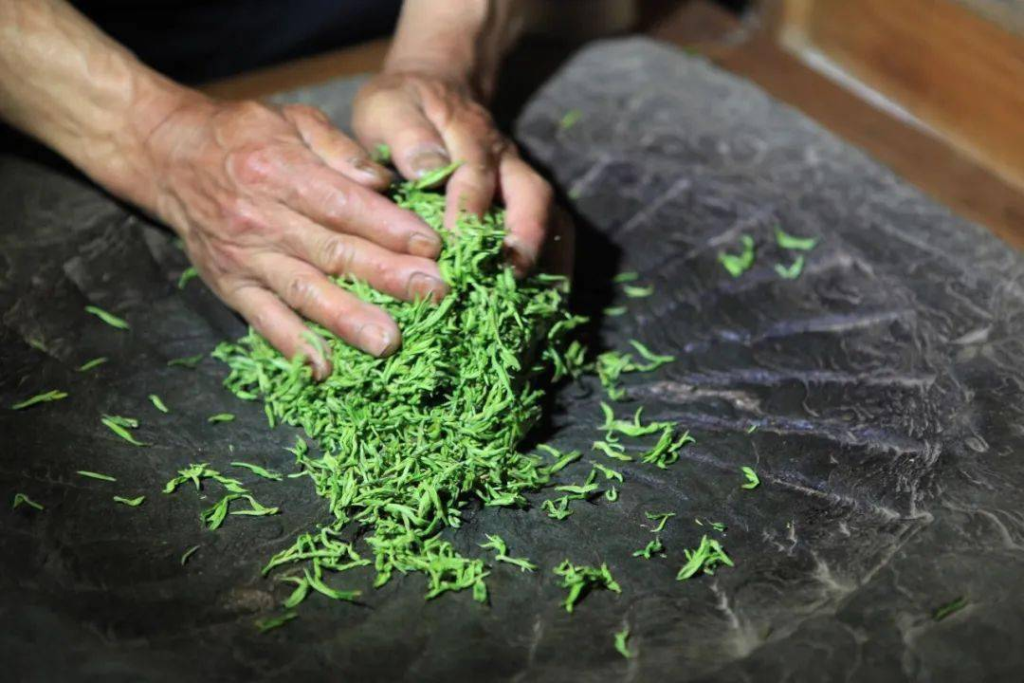Selection of Tea Leaves
The first step in making green tea is to select the right tea leaves. The best green tea leaves are picked in early spring, when they are young, tender, and rich in natural flavors. The leaves should be small, thin, and tightly rolled, with a fresh, grassy aroma.

Preparation of Tea Equipment
A traditional Chinese tea set is essential for making green tea. It usually consists of a teapot, a tea tray, a tea cup, and a tea strainer. Additionally, fresh, clean water that has been boiled and cooled to around 80°C (176°F) is recommended for brewing.

Processing Steps
- Plucking (采青)
- Plucking refers to the process of harvesting the tea leaves. It involves selecting leaves of the appropriate maturity and uniformity, as well as harvesting them at the right time, which are crucial factors determining the quality of the tea.
- Withering (萎凋)
- After plucking, the fresh leaves are spread out on clean utensils with a thickness of 7-10 centimeters. They are then left to wither for 6-12 hours, with occasional turning to ensure even drying. The leaves are ready for the next step when their moisture content reaches 68%-70%, the leaf quality becomes softer, and a fresh aroma emerges.
- Fixation (杀青)
- Fixation is a critical step in green tea processing. It involves using high heat to remove moisture from the leaves, deactivate enzymes, and prevent enzymatic reactions, thereby forming the quality characteristics of green tea and preserving its color and flavor. The temperature and duration of fixation vary depending on the grade and season of the leaves. The leaves should be fixed until they turn dark green, become soft and slightly sticky, with a pleasant tea aroma emanating.
- Rolling (揉捻)
- After fixation, the leaves are rolled like dough to break down the leaf tissue (typically with a cell damage rate of 45-55%), allowing tea sap to adhere to the leaf surface. This step facilitates the release of flavors during brewing, shapes the tea, and prepares it for drying. Rolling can be done hot (immediately after fixation) or cold (after the leaves have cooled down).
- Drying (干燥)
- Drying is the final step in green tea production. It further transforms the internal components of the leaves, enhances their quality, improves their appearance, removes excess moisture to prevent mold, and facilitates storage. Drying can be done through various methods, including sun-drying, steaming, pan-firing, and oven-drying, each resulting in a different type of green tea.

Types of Green Tea Based on Drying Methods
- Pan-fired Green Tea (炒青绿茶)
- Dried by frying in a pan, this type of green tea is the most common and widely consumed. It has a strong, pan-fried aroma and is represented by teas like Dongting Biluochun, West Lake Longjing, Mengding Ganlu, and Xinyang Maojian.
- Oven-dried Green Tea (烘青绿茶)
- Similar to pan-fired green tea, oven-dried green tea undergoes high-temperature fixation but is dried in an oven rather than a pan. This results in a tea with a higher degree of intactness and a delicate aroma. It is often used as the base for jasmine tea. Notable examples include Huangshan Maofeng and Taiping Houkui.
- Sun-dried Green Tea (晒青绿茶)
- Dried primarily by sunlight, this type of green tea has a strong regional flavor due to its dependence on the local climate. It is usually made from larger leaf varieties and has a rich, bold flavor with a quick finish. Dianqing, made from Yunnan large-leaf varieties, is a representative example.
- Steam-fixed Green Tea (蒸青绿茶)
- This type of green tea undergoes fixation through steaming, a method that dates back to ancient times. It has a unique “three greens” characteristic: dark green leaves, light green liquor, and green leaf bottoms. The tea has a slightly grassy aroma and a slightly astringent taste. Enshi Yulu is a well-known example of steam-fixed green tea.
In summary, the production of Chinese green tea involves careful selection of leaves, preparation of equipment, and a series of processing steps including plucking, withering, fixation, rolling, and drying. The drying method determines the specific type of green tea produced, each with its unique flavor and aroma.



